2002 MERCEDES-BENZ SLK 230 KOMPRESSOR srs
[x] Cancel search: srsPage 60 of 290
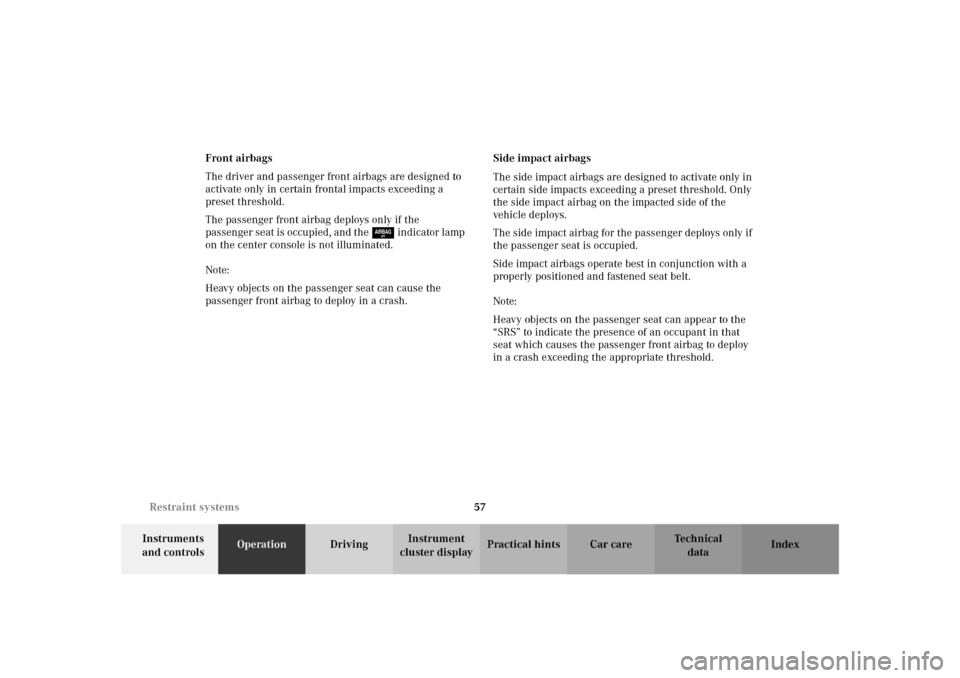
57 Restraint systems
Te ch n i c a l
data Instruments
and controlsOperationDrivingInstrument
cluster displayPractical hints Car care Index Front airbags
The driver and passenger front airbags are designed to
activate only in certain frontal impacts exceeding a
preset threshold.
The passenger front airbag deploys only if the
passenger seat is occupied, and the 7 indicator lamp
on the center console is not illuminated.
Note:
Heavy objects on the passenger seat can cause the
passenger front airbag to deploy in a crash.Side impact airbags
The side impact airbags are designed to activate only in
certain side impacts exceeding a preset threshold. Only
the side impact airbag on the impacted side of the
vehicle deploys.
The side impact airbag for the passenger deploys only if
the passenger seat is occupied.
Side impact airbags operate best in conjunction with a
properly positioned and fastened seat belt.
Note:
Heavy objects on the passenger seat can appear to the
“SRS” to indicate the presence of an occupant in that
seat which causes the passenger front airbag to deploy
in a crash exceeding the appropriate threshold.
Page 61 of 290
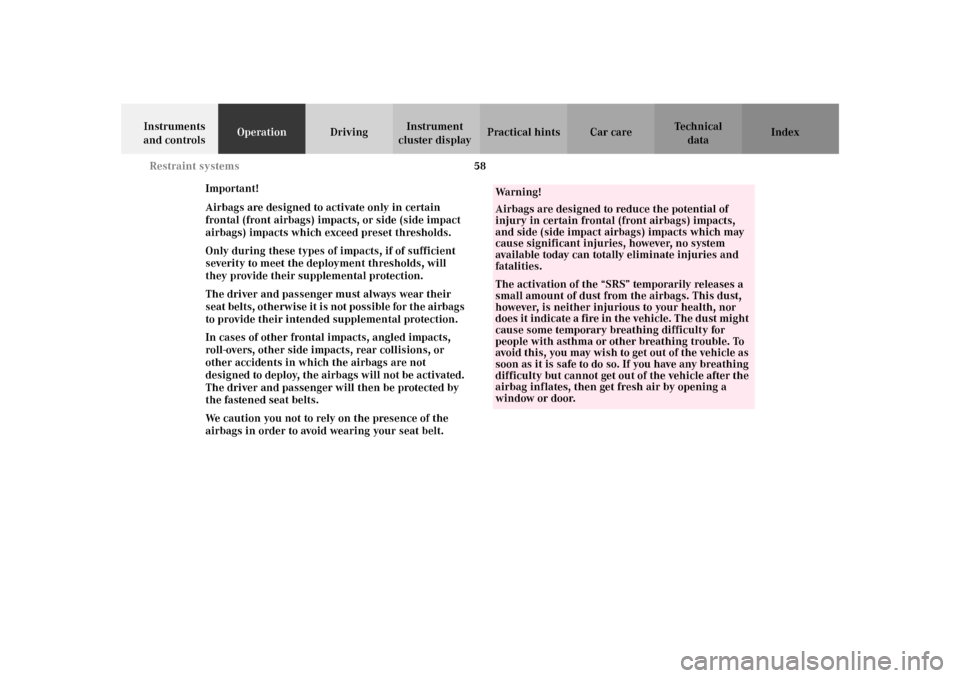
58 Restraint systems
Te ch n i c a l
data Instruments
and controlsOperationDrivingInstrument
cluster displayPractical hints Car care Index
Important!
Airbags are designed to activate only in certain
frontal (front airbags) impacts, or side (side impact
airbags) impacts which exceed preset thresholds.
Only during these types of impacts, if of sufficient
severity to meet the deployment thresholds, will
they provide their supplemental protection.
The driver and passenger must always wear their
seat belts, otherwise it is not possible for the airbags
to provide their intended supplemental protection.
In cases of other frontal impacts, angled impacts,
roll-overs, other side impacts, rear collisions, or
other accidents in which the airbags are not
designed to deploy, the airbags will not be activated.
The driver and passenger will then be protected by
the fastened seat belts.
We caution you not to rely on the presence of the
airbags in order to avoid wearing your seat belt.
Wa r n i n g !
Airbags are designed to reduce the potential of
injury in certain frontal (front airbags) impacts,
and side (side impact airbags) impacts which may
cause significant injuries, however, no system
available today can totally eliminate injuries and
fatalities.The activation of the “SRS” temporarily releases a
small amount of dust from the airbags. This dust,
however, is neither injurious to your health, nor
does it indicate a fire in the vehicle. The dust might
cause some temporary breathing difficulty for
people with asthma or other breathing trouble. To
avoid this, you may wish to get out of the vehicle as
soon as it is safe to do so. If you have any breathing
difficulty but cannot get out of the vehicle after the
airbag inflates, then get fresh air by opening a
window or door.
Page 64 of 290
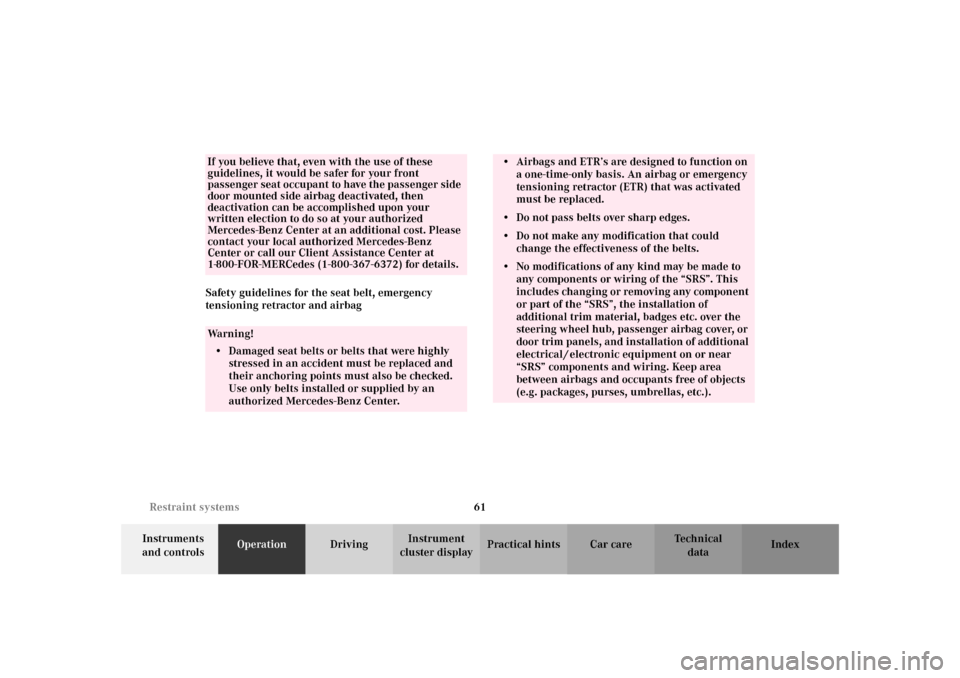
61 Restraint systems
Te ch n i c a l
data Instruments
and controlsOperationDrivingInstrument
cluster displayPractical hints Car care Index Safety guidelines for the seat belt, emergency
tensioning retractor and airbag
If you believe that, even with the use of these
guidelines, it would be safer for your front
passenger seat occupant to have the passenger side
door mounted side airbag deactivated, then
deactivation can be accomplished upon your
written election to do so at your authorized
Mercedes-Benz Center at an additional cost. Please
contact your local authorized Mercedes-Benz
Center or call our Client Assistance Center at
1-800-FOR-MERCedes (1-800-367-6372) for details.Wa r n i n g !
• Damaged seat belts or belts that were highly
stressed in an accident must be replaced and
their anchoring points must also be checked.
Use only belts installed or supplied by an
authorized Mercedes-Benz Center.
• Airbags and ETR’s are designed to function on
a one-time-only basis. An airbag or emergency
tensioning retractor (ETR) that was activated
must be replaced.• Do not pass belts over sharp edges.• Do not make any modification that could
change the effectiveness of the belts.• No modifications of any kind may be made to
any components or wiring of the “SRS”. This
includes changing or removing any component
or part of the “SRS”, the installation of
additional trim material, badges etc. over the
steering wheel hub, passenger airbag cover, or
door trim panels, and installation of additional
electrical / electronic equipment on or near
“SRS” components and wiring. Keep area
between airbags and occupants free of objects
(e.g. packages, purses, umbrellas, etc.).
Page 65 of 290
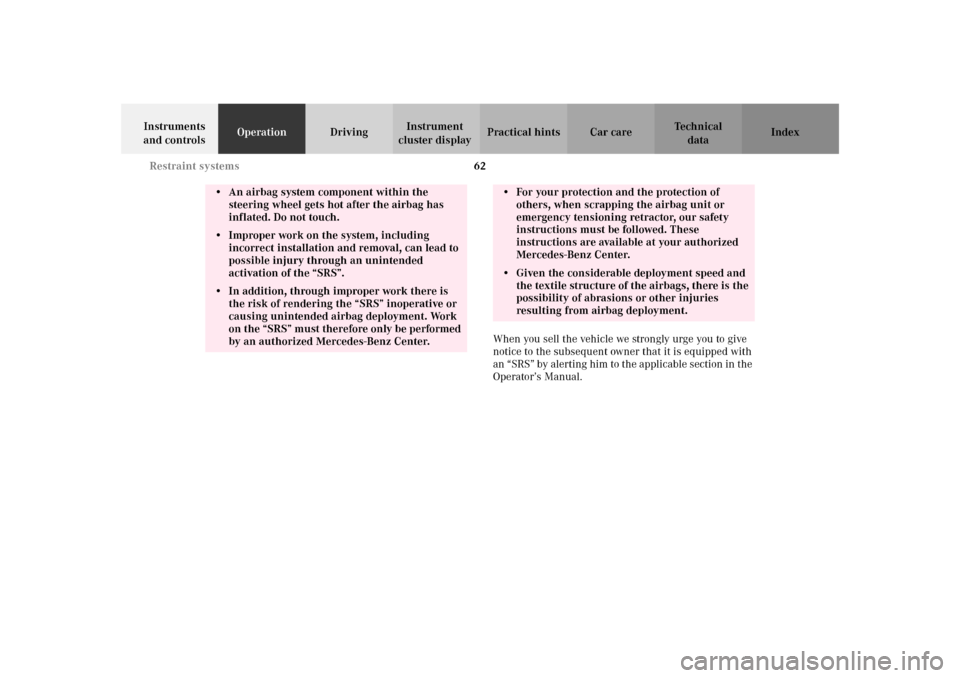
62 Restraint systems
Te ch n i c a l
data Instruments
and controlsOperationDrivingInstrument
cluster displayPractical hints Car care Index
When you sell the vehicle we strongly urge you to give
notice to the subsequent owner that it is equipped with
an “SRS” by alerting him to the applicable section in the
Operator’s Manual.
• An airbag system component within the
steering wheel gets hot after the airbag has
inflated. Do not touch.• Improper work on the system, including
incorrect installation and removal, can lead to
possible injury through an unintended
activation of the “SRS”.• In addition, through improper work there is
the risk of rendering the “SRS” inoperative or
causing unintended airbag deployment. Work
on the “SRS” must therefore only be performed
by an authorized Mercedes-Benz Center.
• For your protection and the protection of
others, when scrapping the airbag unit or
emergency tensioning retractor, our safety
instructions must be followed. These
instructions are available at your authorized
Mercedes-Benz Center.• Given the considerable deployment speed and
the textile structure of the airbags, there is the
possibility of abrasions or other injuries
resulting from airbag deployment.
Page 75 of 290

72 Instrument cluster
Te ch n i c a l
data Instruments
and controlsOperationDrivingInstrument
cluster displayPractical hints Car care Index
Indicator lamps in the instrument cluster
High beam
ABS malfunction, see page 186
Brake fluid low (except Canada).
Parking brake engaged, see page 183
Brake fluid low (Canada only).
Parking brake engaged, see page 183
BAS malfunction, see page 185
ESP malfunction, see page 185
ESP warning lamp. Adjust driving to road
condition, see page 185
Fasten seat belts, see page 184
Fluid level for windshield and headlamp
washer system low, see page 187
Coolant level low, see page 187
Engine oil level low, see page 188Brake pads worn down, see page 184
Battery not being charged properly,
see page 188
Exterior lamp failure, see page 189
Telescoping steering column not locked,
see page 186
SRS malfunction, see page 184
Engine malfunction indicator lamp. If the
“CHECK ENGINE” malfunction indicator
lamp comes on when the engine is running,
it indicates a malfunction of the fuel
management system, emission control
system, systems which impact emissions, or
the fuel cap is not closed tight. In all cases,
we recommend that you have the
malfunction checked as soon as possible, see
page 182
ABS
Page 184 of 290
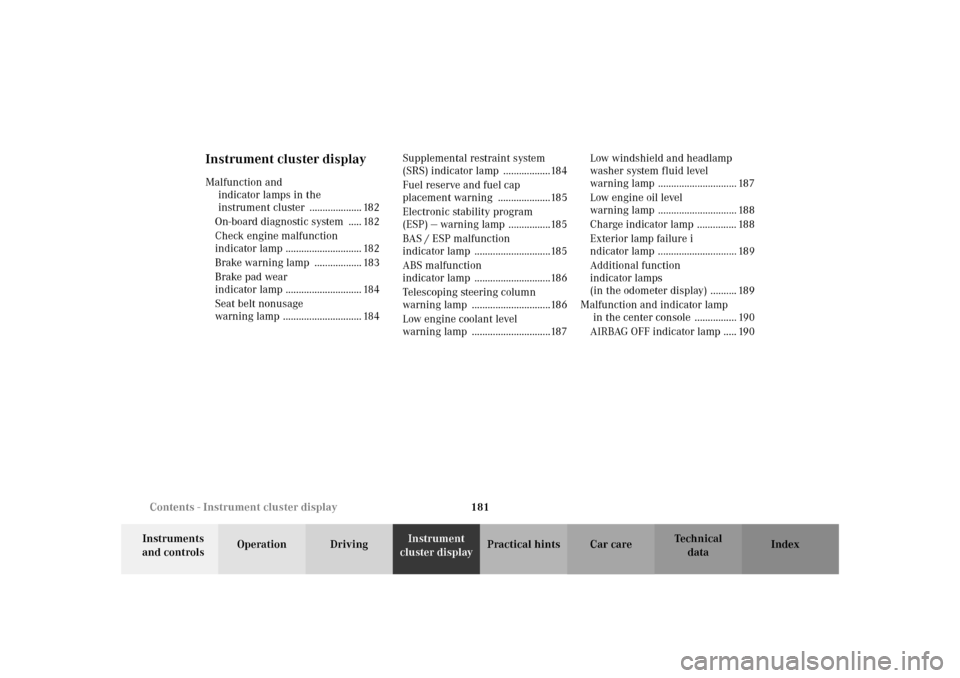
181 Contents - Instrument cluster display
Te ch n i c a l
data Instruments
and controlsOperation DrivingInstrument
cluster displayPractical hints Car care Index
Instrument cluster displayMalfunction and
indicator lamps in the
instrument cluster .................... 182
On-board diagnostic system ..... 182
Check engine malfunction
indicator lamp ............................. 182
Brake warning lamp .................. 183
Brake pad wear
indicator lamp ............................. 184
Seat belt nonusage
warning lamp .............................. 184Supplemental restraint system
(SRS) indicator lamp ..................184
Fuel reserve and fuel cap
placement warning ....................185
Electronic stability program
(ESP) — warning lamp ................185
BAS / ESP malfunction
indicator lamp .............................185
ABS malfunction
indicator lamp .............................186
Telescoping steering column
warning lamp ..............................186
Low engine coolant level
warning lamp ..............................187Low windshield and headlamp
washer system fluid level
warning lamp .............................. 187
Low engine oil level
warning lamp .............................. 188
Charge indicator lamp ............... 188
Exterior lamp failure i
ndicator lamp .............................. 189
Additional function
indicator lamps
(in the odometer display) .......... 189
Malfunction and indicator lamp
in the center console ................ 190
AIRBAG OFF indicator lamp ..... 190
Page 187 of 290

184 Malfunction and indicator lamps
Te ch n i c a l
data Instruments
and controlsOperation DrivingInstrument
cluster displayPractical hints Car care Index
Brake pad wear indicator lamp
With the key in steering lock position 2, the
brake pad wear indicator lamp comes on. It
goes out when the engine is running.
If the indicator lamp lights up during braking, this
indicates that the brake pads are worn down.
Have the brake system checked at your authorized
Mercedes-Benz Center as soon as possible.
Seat belt nonusage warning lamp
With the key in steering lock position 2, the
seat belt warning lamp comes on, and a
warning sounds for a short time if the
driver’s seat belt is not fastened.
After starting the engine, the seat belt warning lamp
blinks for a brief period to remind the driver and
passengers to fasten seat belts.Supplemental restraint system (SRS) indicator lamp
The operational readiness of the airbag
system is verified by the indicator lamp
“SRS” in the instrument cluster when
turning the key in steering lock to position 1 or 2. If no
fault is detected, the lamp will go out after
approximately 4 seconds; after the lamp goes out, the
system continues to monitor the components and
circuitry of the airbag system and will indicate a
malfunction by coming on again.
See page 54 for notes on airbags, see page 53 for belt
tensioners and page 44 for infant and child seat
restraint.
Wa r n i n g !
In the event a malfunction of the “SRS” is indicated
as outlined above, the “SRS” may not be
operational. For your safety, we strongly
recommend that you visit an authorized
Mercedes-Benz Center immediately to have the
system checked; otherwise the “SRS” may not be
activated when needed in an accident, which could
result in serious or fatal injury, or it might deploy
unexpectedly and unnecessarily which could also
result in injury.
Page 279 of 290

276 Index
Te ch n i c a l
data Instruments
and controlsOperation DrivingInstrument
cluster displayPractical hints Car careIndex
Clock, setting .................................................................... 76
Coin Holder ......................................................................116
Combination switch ........................................................ 83
Consumer information .................................................. 272
Control and operation of radio transmitters ............. 130
Coolant level
Adding coolant .......................................................... 198
Checking .................................................................... 198
Coolant temperature gauge ............................................ 75
Coolants ........................................................................... 270
Anticorrosion/antifreeze quantity ......................... 271
Cruise control ................................................................. 166
Cup holder .......................................................................114
DDaytime running lamps .................................................. 82
Deep water
Driving instructions ................................................. 165
Display illumination ........................................................ 74
Doors .................................................................................. 28
Drinking and driving .................................................... 157
Drive sensibly - Save Fuel ............................................ 157
Driving instructions ...................................................... 157
Driving off ....................................................................... 159
EElectronic stability program (ESP) .............................. 173
Control switch ........................................................... 175
Malfunction indicator lamp ..................................... 185
Synchronizing ........................................................... 174
Warning lamp ............................................................ 185
Emergency call
See Tele Aid ............................................................... 132
Emergency release for trunk lid .................................... 35
Emergency tensioning retractor (ETR) .........................53
SRS indicator lamp ................................................... 184
Emergency unlocking in case of accident ...................32
Emission control ............................................................ 141
Emission control label .................................................. 256
Engine compartment ..................................................... 194
Engine oil additives ...................................................... 268
Engine oil consumption ..................................................80
Engine oil level
Checking .............................................................. 79, 197
Warning ...................................................................... 188
Engine oil level indicator ................................................ 79
Engine oils ..................................................................... 268
ESP (Electronic stability program) .............................. 173
Control switch ........................................................... 175
Malfunction indicator lamp ..................................... 185